TIFF
Revision 6.0
Final — June 3, 1992
Author/Editor/Arbitrator: Steve Carlsen, Principal Engineer, Aldus Corporation
Aldus Developers Desk
Aldus Corporation
411 First Avenue South
Seattle, WA 98104-2871
CompuServe: GO ALDSVC, Message Section #10
Applelink:
Aldus Developers Icon
For a copy of the TIFF 6.0 specification, call (206) 628-6593.
If you have questions about the contents of this specification, see page 8.
160-640M
�
TIFF 6.0 Specification
Final—June 3, 1992
Copyright
1986-1988, 1992 Aldus Corporation. Permission to copy without fee all or part
of this material is granted provided that the copies are not made or distributed for
direct commercial advantage and the Aldus copyright notice appears. If the major-
ity of the document is copied or redistributed, it must be distributed verbatim,
without repagination or reformatting. To copy otherwise requires specific permis-
sion from the Aldus Corporation.
Licenses and Trademarks
Aldus and PageMaker are registered trademarks and TIFF is a trademark of Aldus
Corporation. Apple and Macintosh are registered trademarks of Apple Computer,
Inc. MS-DOS is a registered trademark of Microsoft Corporation. UNIX is a
trademark of Bell Laboratories. CompuServe is a registered trademark of
CompuServe Inc. PostScript is a registered trademark of Adobe Systems Inc. and
all references to PostScript in this document are references to either the PostScript
interpreter or language. Kodak and PhotoYCC are trademarks of Eastman Kodak
Company.
Rather than put a trademark symbol in every occurrence of other trademarked
names, we state that we are using the names only in an editorial fashion, and to the
benefit of the trademark owner, with no intention of infringement of the trade-
mark.
Acknowledgments
This specification is the result of much hard work by many people.
Some of the sections in Part 2 were written by a number of outside contributors:
Ed Beeman, Hewlett Packard
Nancy Cam, Silicon Graphics
Dennis Hamilton, Xerox
Eric Hamilton, C-Cube
Sam Leffler, Silicon Graphics
Chris and Dan Sears
Other primary reviewers and TAC meeting participants include representatives
from Apple, Camex, Crosfield, Digital Optics Limited, Frame, IBM, Interleaf,
Island Graphics, Kodak, Linotype-Hell, Quark, Sun Microsystems, Time Arts,
US West, and Wang. Many thanks to all for lending their time and talents to this
effort.
No document this large can completely satisfy everyone, but we have all worked
hard to strike an effective balance between power and simplicity, between formal-
ity and approachability, and between flexibility and constraints.
Production Notes
This document was created electronically using Aldus PageMaker 4.2.
2
�
TIFF 6.0 Specification
Final—June 3, 1992
Contents
Introduction ....................................................................................................................4
About this Specification......................................................................4
Revision Notes.....................................................................................6
TIFF Administration.............................................................................8
Information and Support.........................................................................8
Private Fields and Values.......................................................................8
Submitting a Proposal............................................................................9
The TIFF Advisory Committee...............................................................9
Other TIFF Extensions...........................................................................9
Part 1: Baseline TIFF ....................................................................................................11
Section 1: Notation............................................................................12
Section 2: TIFF Structure...................................................................13
Section 3: Bilevel Images..................................................................17
Section 4: Grayscale Images............................................................22
Section 5: Palette-color Images........................................................23
Section 6: RGB Full Color Images....................................................24
Section 7: Additional Baseline TIFF Requirements........................26
Section 8: Baseline Field Reference Guide.....................................28
Section 9: PackBits Compression....................................................42
Section 10: Modified Huffman Compression...................................43
Part 2: TIFF Extensions ..............................................................................................48
Section 11: CCITT Bilevel Encodings..............................................49
Section 12: Document Storage and Retrieval..................................55
Section 13: LZW Compression.........................................................57
Section 14: Differencing Predictor...................................................64
Section 15: Tiled Images...................................................................66
Section 16: CMYK Images.................................................................69
Section 17: HalftoneHints..................................................................72
Section 18: Associated Alpha Handling...........................................77
Section 19: Data Sample Format......................................................80
Section 20: RGB Image Colorimetry................................................82
Section 21: YCbCr Images ................................................................89
Section 22: JPEG Compression.......................................................95
Section 23: CIE L*a*b* Images........................................................110
Part 3: Appendices ....................................................................................................116
Appendix A: TIFF Tags Sorted by Number....................................117
Appendix B: Operating System Considerations...........................119
Index ............................................................................................................................120
3
�
TIFF 6.0 Specification
Final—June 3, 1992
Introduction
About this Specification
History
Scope
This document describes TIFF, a tag-based file format for storing and interchang-
ing raster images.
The first version of the TIFF specification was published by Aldus Corporation in
the fall of 1986, after a series of meetings with various scanner manufacturers and
software developers. It did not have a revision number but should have been la-
beled Revision 3.0 since there were two major earlier draft releases.
Revision 4.0 contained mostly minor enhancements and was released in April
1987. Revision 5.0, released in October 1988, added support for palette color
images and LZW compression.
TIFF describes image data that typically comes from scanners, frame grabbers,
and paint- and photo-retouching programs.
TIFF is not a printer language or page description language. The purpose of TIFF
is to describe and store raster image data.
A primary goal of TIFF is to provide a rich environment within which applica-
tions can exchange image data. This richness is required to take advantage of the
varying capabilities of scanners and other imaging devices.
Though TIFF is a rich format, it can easily be used for simple scanners and appli-
cations as well because the number of required fields is small.
TIFF will be enhanced on a continuing basis as new imaging needs arise. A high
priority has been given to structuring TIFF so that future enhancements can be
added without causing unnecessary hardship to developers.
4
�
TIFF 6.0 Specification
Features
Final—June 3, 1992
• TIFF is capable of describing bilevel, grayscale, palette-color, and full-color
image data in several color spaces.
• TIFF includes a number of compression schemes that allow developers to
choose the best space or time tradeoff for their applications.
• TIFF is not tied to specific scanners, printers, or computer display hardware.
• TIFF is portable. It does not favor particular operating systems, file systems,
compilers, or processors.
• TIFF is designed to be extensible—to evolve gracefully as new needs arise.
• TIFF allows the inclusion of an unlimited amount of private or special-purpose
information.
5
�
TIFF 6.0 Specification
Final—June 3, 1992
Revision Notes
This revision replaces TIFF Revision 5.0.
Paragraphs that contain new or substantially-changed information are shown in
italics.
New Features in Revision 6.0
Clarifications
Major enhancements to TIFF 6.0 are described in Part 2. They include:
• CMYK image definition
• A revised RGB Colorimetry section.
• YCbCr image definition
• CIE L*a*b* image definition
• Tiled image definition
•
JPEG compression
• The LZW compression section more clearly explains when to switch the cod-
ing bit length.
• The interaction between Compression=2 (CCITT Huffman) and
PhotometricInterpretation was clarified.
• The data organization of uncompressed data (Compression=1) when
BitsPerSample is greater than 8 was clarified. See the Compression field de-
scription.
• The discussion of CCITT Group 3 and Group 4 bilevel image encodings was
clarified and expanded, and Group3Options and Group4Options fields were
renamed T4Options and T6Options. See Section 11.
Organizational Changes
• To make the organization more consistent and expandable, appendices were
transformed into numbered sections.
• The document was divided into two parts—Baseline and Extensions—to help
developers make better and more consistent implementation choices. Part 1,
the Baseline section, describes those features that all general-purpose TIFF
readers should support. Part 2, the Extensions section, describes a number of
features that can be used by special or advanced applications.
• An index and table of contents were added.
6
�
TIFF 6.0 Specification
Final—June 3, 1992
Changes in Requirements
• To illustrate a Baseline TIFF file earlier in the document, the material from
Appendix G (“TIFF Classes”) in Revision 5 was integrated into the main body
of the specification . As part of this integration, the TIFF Classes terminology
was replaced by the more monolithic Baseline TIFF terminology. The intent
was to further encourage all mainstream TIFF readers to support the Baseline
TIFF requirements for bilevel, grayscale, RGB, and palette-color images.
• Due to licensing issues, LZW compression support was moved out of the “Part
1: Baseline TIFF” and into “Part 2: Extensions.”
• Baseline TIFF requirements for bit depths in palette-color images were weak-
ened a bit.
Changes in Terminology
Compatibility
In previous versions of the specification, the term “tag” reffered both to the identi-
fying number of a TIFF field and to the entire field. In this version, the term “tag”
refers only to the identifying number. The term “field” refers to the entire field,
including the value.
Every attempt has been made to add functionality in such a way as to minimize
compatibility problems with files and software that were based on earlier versions
of the TIFF specification. The goal is that TIFF files should never become obso-
lete and that TIFF software should not have to be revised more frequently than
absolutely necessary. In particular, Baseline TIFF 6.0 files will generally be read-
able even by older applications that assume TIFF 5.0 or an earlier version of the
specification.
However, TIFF 6.0 files that use one of the major new extensions, such as a new
compression scheme or color space, will not be successfully read by older soft-
ware. In such cases, the older applications must gracefully give up and refuse to
import the image, providing the user with a reasonably informative message.
7
�
TIFF 6.0 Specification
Final—June 3, 1992
TIFF Administration
Information and Support
The most recent version of the TIFF specification in PostScript format is available
on CompuServe ("Go ALDSVC", Library 10) and on AppleLink (Aldus Devel-
opers Icon). Sample TIFF files and other TIFF developer information can also be
found at these locations.
The Aldus CompuServe forum (Go ALDSVC) can also be used to post messages
to other TIFF developers, enabling developers to help each other.
Because of the tremendous growth in the usage of TIFF, Aldus is no longer able to
provide a general consulting service for TIFF implementors. TIFF developers are
encouraged to study sample TIFF files, read TIFF documentation thoroughly, and
work with developers of other products that are important to you.
Most companies that use TIFF can answer questions about support for TIFF in
their products. Contact the appropriate product manager or developer support
service group.
If you are an experienced TIFF developer and are interested in contract program-
ming for other developers, please contact Aldus. Aldus can give your name to
others that might need your services.
Private Fields and Values
An organization might wish to store information meaningful to only that organi-
zation in a TIFF file. Tags numbered 32768 or higher, sometimes called private
tags, are reserved for that purpose.
Upon request, the TIFF administrator (the Aldus Developers Desk) will allocate
and register a block of private tags for an organization, to avoid possible conflicts
with other organizations. Tags are normally allocated in blocks of five or less.
You do not need to tell the TIFF administrator or anyone else what you plan to use
them for.
Private enumerated values can be accommodated in a similar fashion. For ex-
ample, you may wish to experiment with a new compression scheme within TIFF.
Enumeration constants numbered 32768 or higher are reserved for private usage.
Upon request, the administrator will allocate and register one or more enumerated
values for a particular field (Compression, in our example), to avoid possible
conflicts.
Tags and values allocated in the private number range are not prohibited from
being included in a future revision of this specification. Several such instances
exist in the TIFF specification.
Do not choose your own tag numbers. Doing so could cause serious compatibility
problems in the future.
8
�
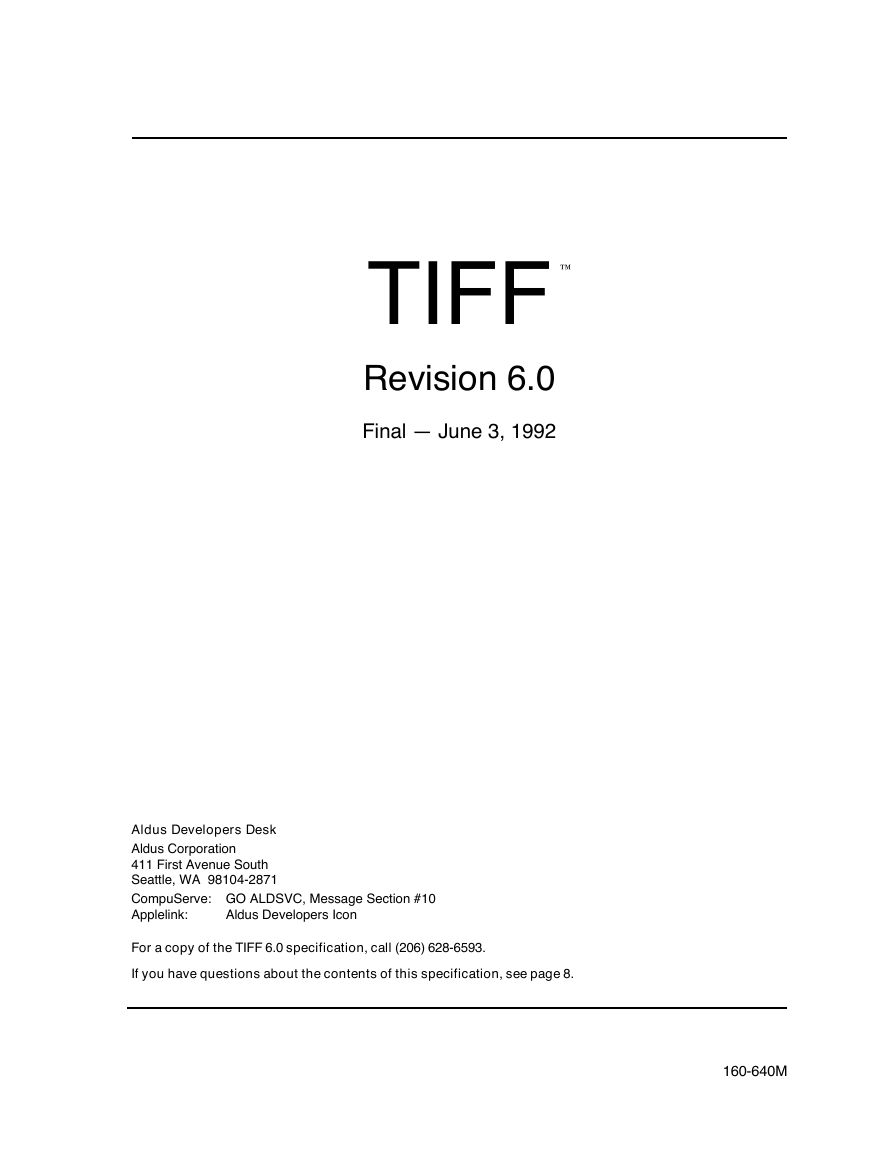
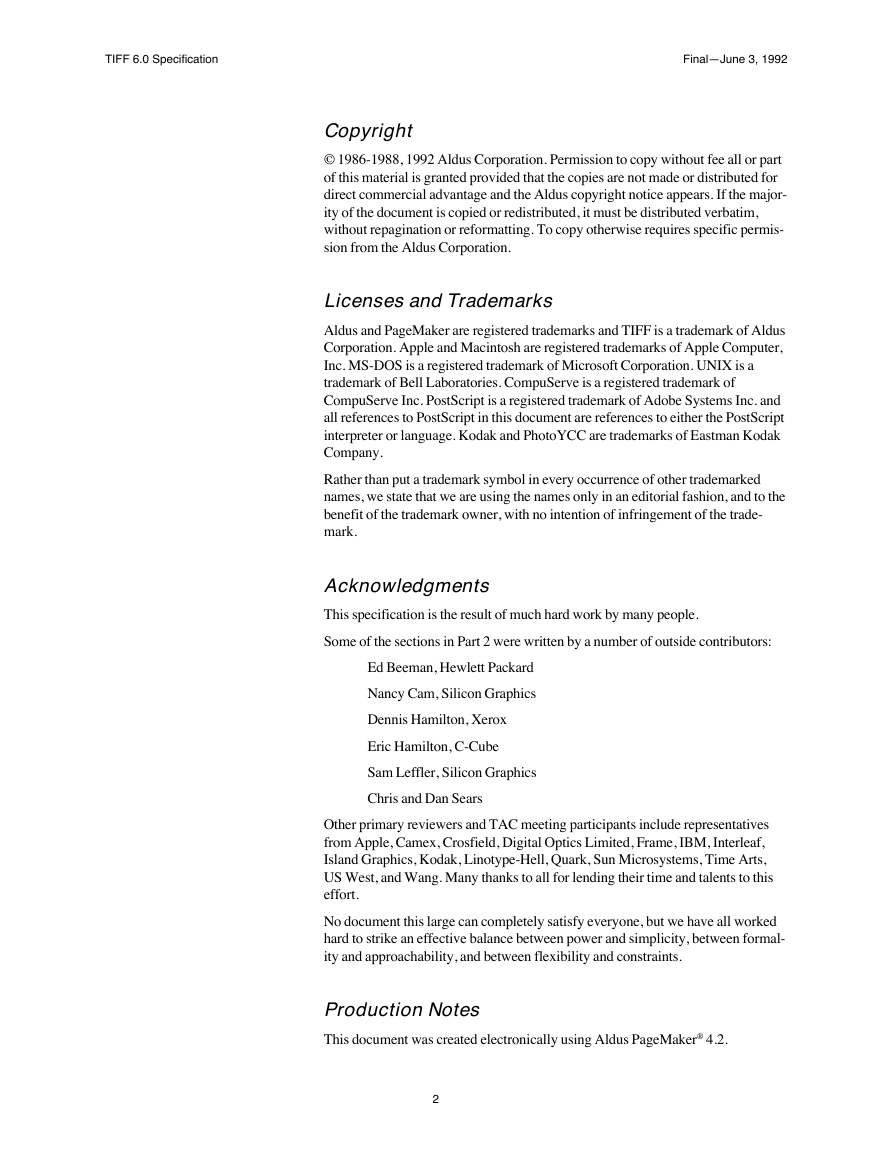

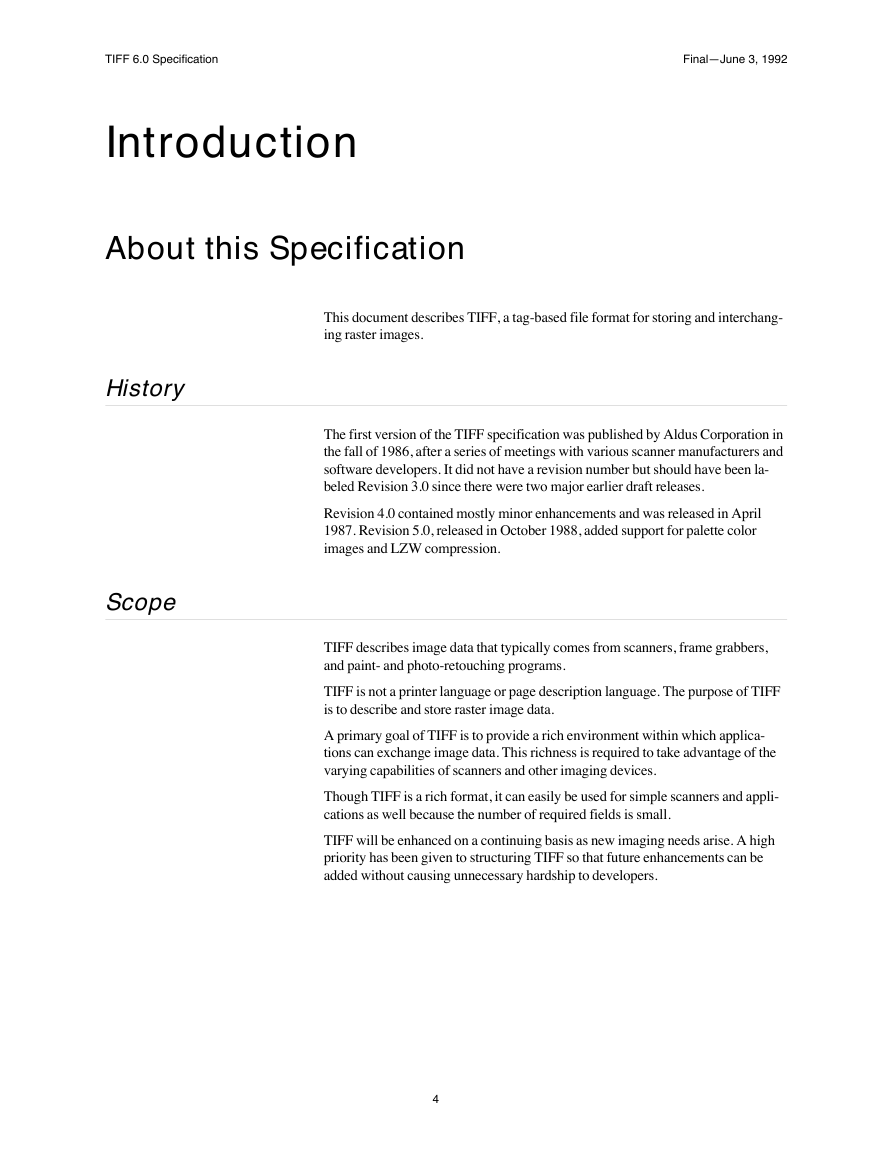
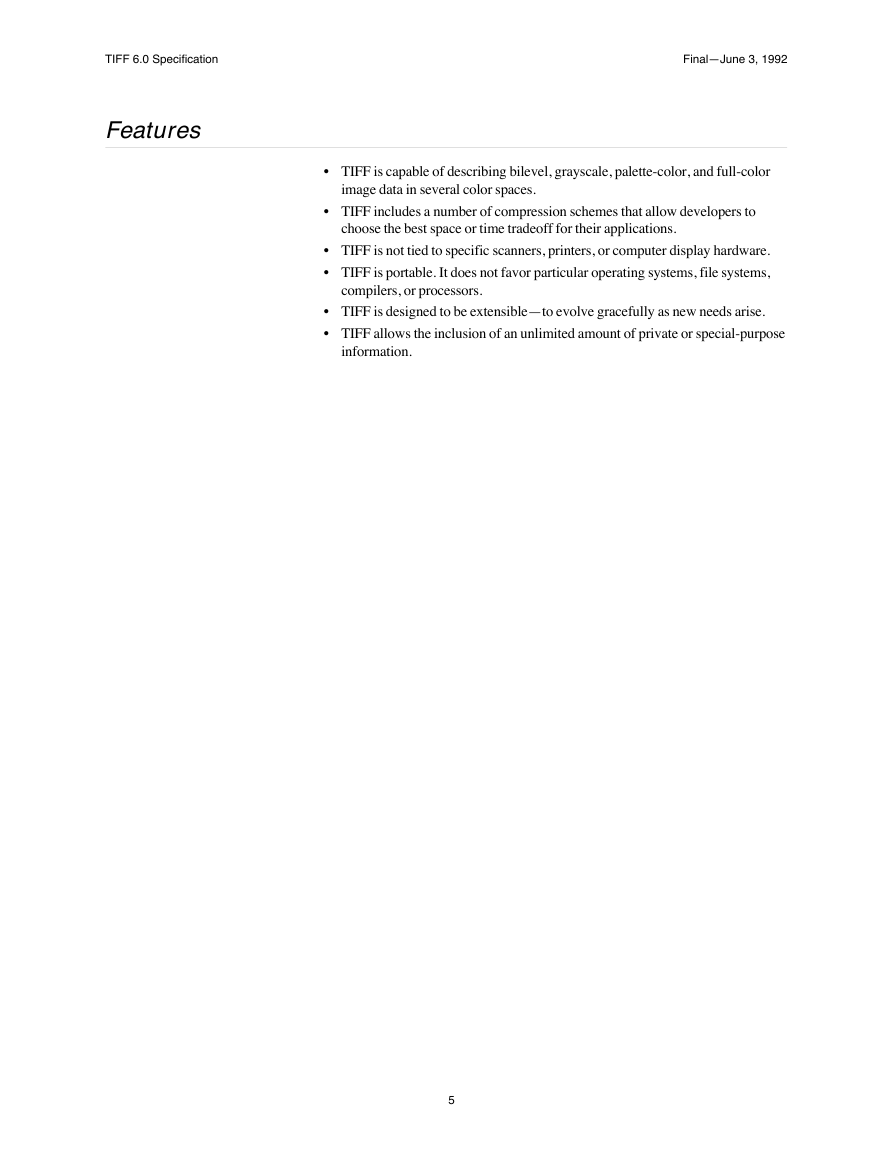
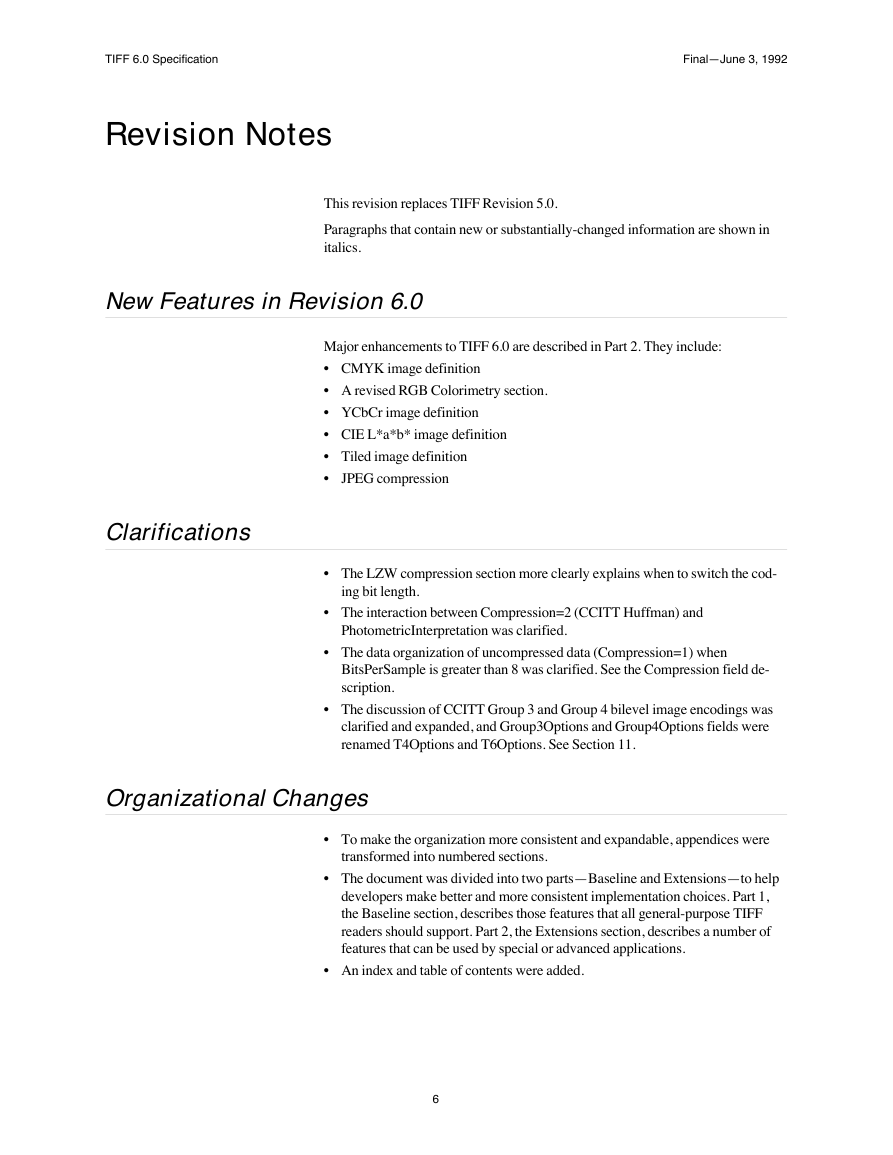
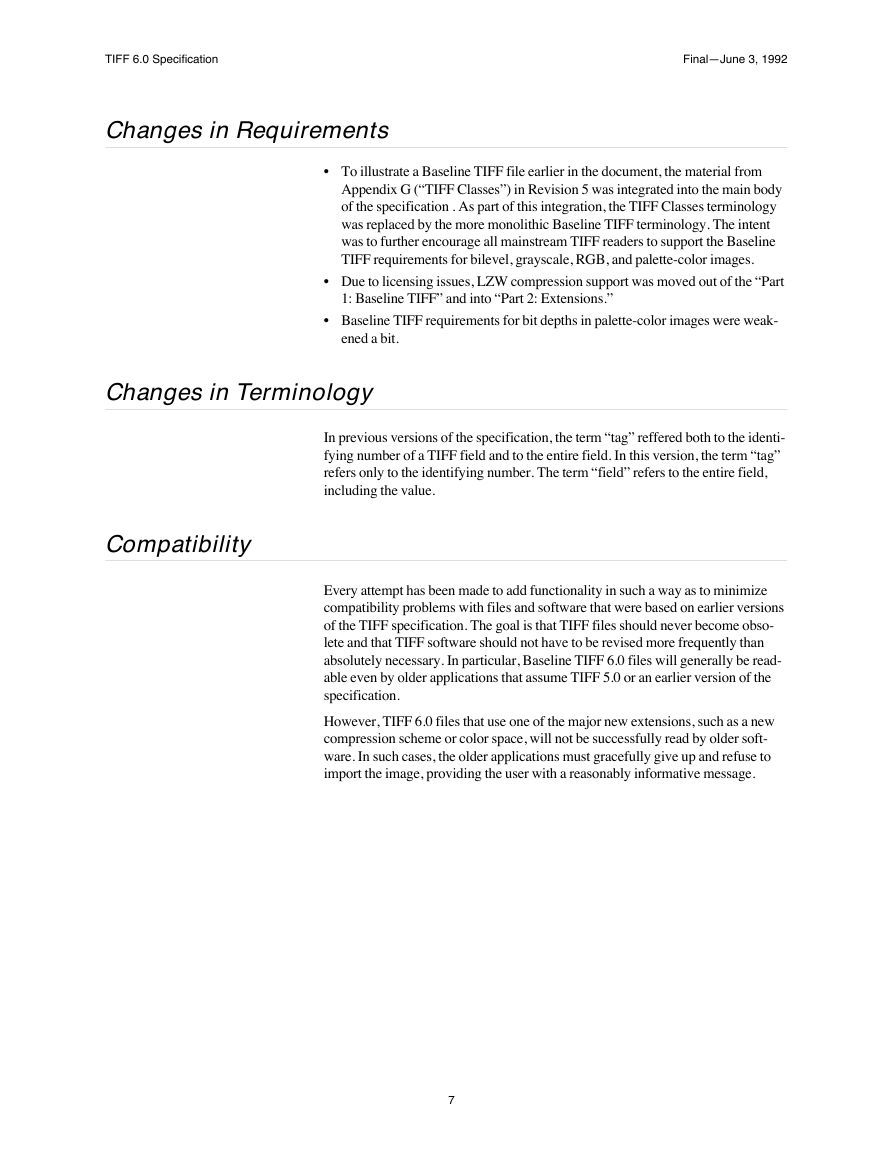
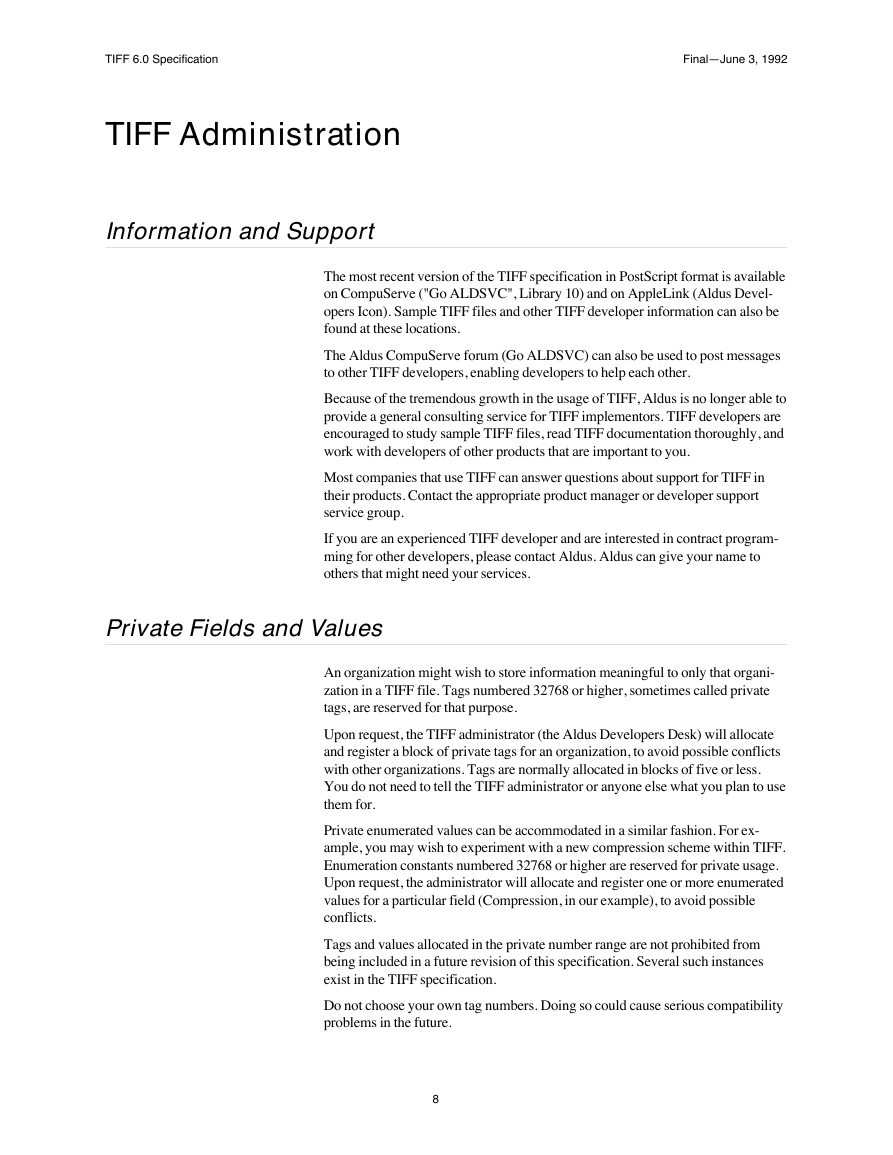








 2023年江西萍乡中考道德与法治真题及答案.doc
2023年江西萍乡中考道德与法治真题及答案.doc 2012年重庆南川中考生物真题及答案.doc
2012年重庆南川中考生物真题及答案.doc 2013年江西师范大学地理学综合及文艺理论基础考研真题.doc
2013年江西师范大学地理学综合及文艺理论基础考研真题.doc 2020年四川甘孜小升初语文真题及答案I卷.doc
2020年四川甘孜小升初语文真题及答案I卷.doc 2020年注册岩土工程师专业基础考试真题及答案.doc
2020年注册岩土工程师专业基础考试真题及答案.doc 2023-2024学年福建省厦门市九年级上学期数学月考试题及答案.doc
2023-2024学年福建省厦门市九年级上学期数学月考试题及答案.doc 2021-2022学年辽宁省沈阳市大东区九年级上学期语文期末试题及答案.doc
2021-2022学年辽宁省沈阳市大东区九年级上学期语文期末试题及答案.doc 2022-2023学年北京东城区初三第一学期物理期末试卷及答案.doc
2022-2023学年北京东城区初三第一学期物理期末试卷及答案.doc 2018上半年江西教师资格初中地理学科知识与教学能力真题及答案.doc
2018上半年江西教师资格初中地理学科知识与教学能力真题及答案.doc 2012年河北国家公务员申论考试真题及答案-省级.doc
2012年河北国家公务员申论考试真题及答案-省级.doc 2020-2021学年江苏省扬州市江都区邵樊片九年级上学期数学第一次质量检测试题及答案.doc
2020-2021学年江苏省扬州市江都区邵樊片九年级上学期数学第一次质量检测试题及答案.doc 2022下半年黑龙江教师资格证中学综合素质真题及答案.doc
2022下半年黑龙江教师资格证中学综合素质真题及答案.doc